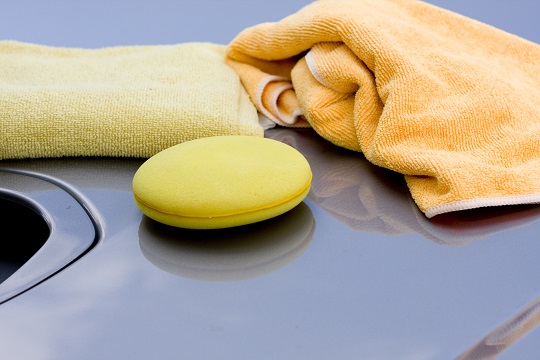
Waxing a vehicle preserves that clean and shiny finish and seals its “pores” against dirt, water vapor, and rust. If water doesn’t bead on the surface of the vehicle when it rains or when you hose it down, it needs waxing. Even if you use a car-washing product that has wax in it, you must still give most vehicles a thorough waxing at least twice a year.
To avoid scratching the surface and trapping minute particles of dust, always be sure to wash the vehicle before you wax it, no matter how clean it looks. After applying wax or polymer sealant, use a terry cloth towel to break up the hazy surface by rubbing in one direction. Then switch to a soft, lint-free cloth (a cloth diaper works best) and rub in the other direction to bring out the shine.
If you drive a dark-colored vehicle or one with a clear-coat or sensitive lacquer finish, make sure that the cleaners and waxes you use have no abrasives in them. If you’re unsure as to whether the finish on your vehicle requires special handling, check your owner’s manual or call your dealership for instructions.
nless your vehicle came with specific instructions from the manufacturer, you can choose from a variety of waxes. Here’s a closer look at your options:
-
Liquid waxes: Generally speaking, liquid waxes are very easy to use but don’t last as long as soft or hard waxes. Liquid wax is excellent to replace the wax you lose if you wash your car with a wax-free detergent or soap, or for a touch-up between professional waxings.
-
Soft waxes: Soft waxes are light and fluffy and are very easy to apply and remove. Some are mixed with a light cleaner, but be sure to wash the car thoroughly first anyway to remove particles that can scratch it. Apply soft wax with the applicator pads provided or with a soft terry cloth rag. Simply wipe on the wax, following the contours of the surface; allow it to dry to a haze; and wipe the haze away.
Because the waxes that contain cleaners usually contain abrasives, don’t use them for every car wash or more often than once a month. In between, use a liquid car cleanser that contains a little wax.
-
Hard or paste waxes: These types of waxes provide the most protection and should be used for your semi-annual major wax job. Always do a small area at a time to avoid letting the wax harden to a point where it’s hard to remove. Apply the wax according to the directions on the can with an applicator or soft, lint-free rag.
-
Polymer preservatives: Products that contain polymer substances claim to protect a vehicle more effectively than wax and for longer periods of time. They bond with the surface and prevent it from fading and oxidizing. At the auto supply store, you can buy poly-sealants that are easy to apply and are supposed to protect your vehicle for six months to a year.
-
Polyglycotes: Professionals and auto manufacturers offer silicon-based polyglycotes that are supposed to last from two to five years, but the jury’s still out on whether they can live up to their promises; most have to be freshened and buffed periodically to maintain the shine, which isn’t much different than waxing. If you still want to use one of these products, wash the vehicle thoroughly and give it a good cleaning and polishing first. When the surface is really clean, shiny, and dry, apply the protective coating, following the directions on the label.
Source: Dummies
